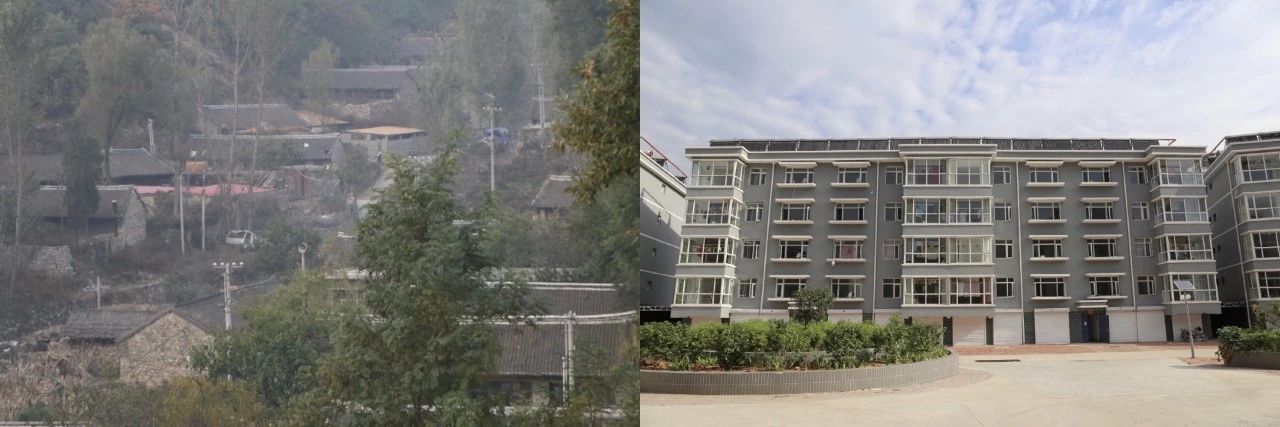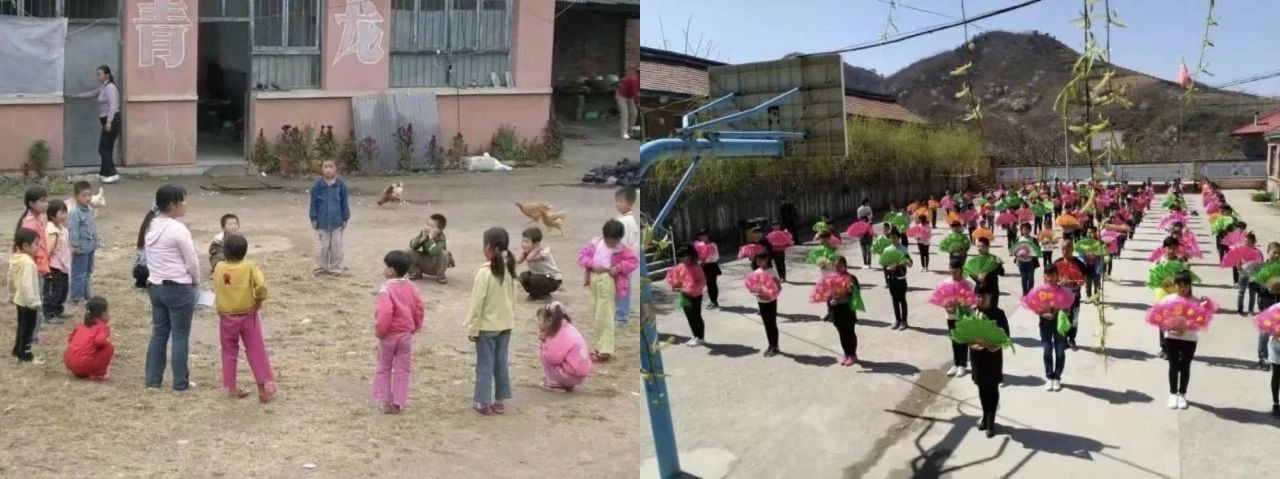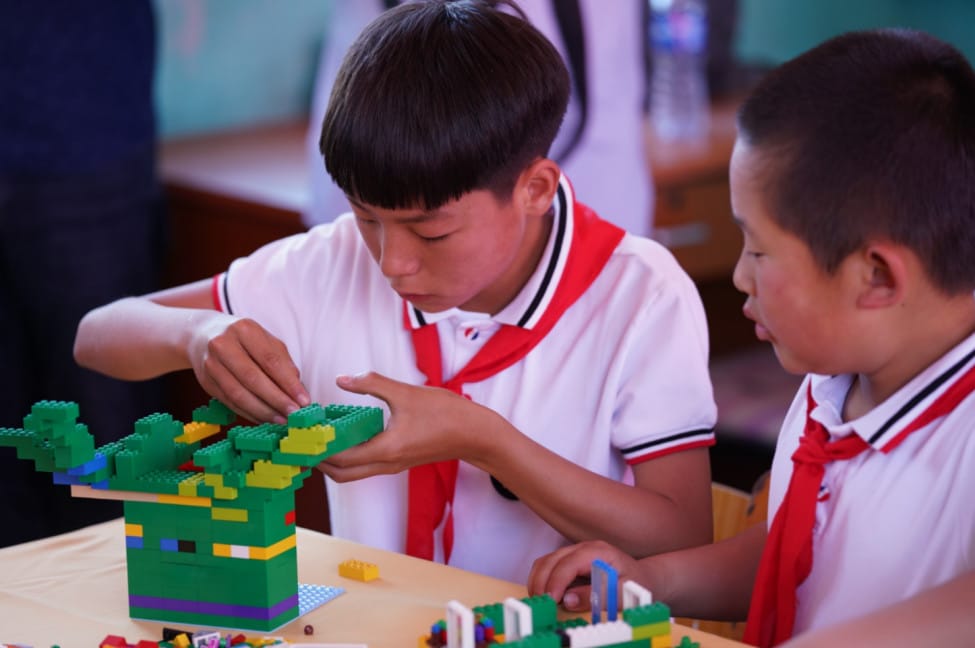Editor’s Note
This is a translation of an article originally published by the Charity Times (公益时报) in June 2019, and written by Zhang Mingmin (click here for the original). It talks about how a small rural primary school in Hebei Province, which was fated to be shut down due to its small size, managed instead to keep going and become a model of rural revitalization, implementing innovative programs to help the children realize their full potential. This was achieved thanks to the vision and hard work of the principal and of the China Zigen Association, and to the support of the Ma Yun Foundation and the Lego Group.
On the day before China’s Children’s Day, which falls on the first of June, the Dasendian Primary School in Gehetou Township, Qinglong Manchu Autonomous County, Qinhuangdao City, Hebei Province held a groundbreaking activity with Lego blocks, which they called “Creative Countryside, Creating a Children’s Day Dream”. The school’s 164 students and 11 teachers led the activity.
On the day, more than a hundred students and teachers from the Dasendian Primary School worked together creatively and used Lego to harness their inexhaustible imagination and build their ideal village youth palace. It was the first time the children got to use Lego. Compared to urban children, village children have less access to toys and other materials, but with the arrival of Lego this has now changed.
One would never think that this school (which is a “complete primary school”, meaning it teaches first to sixth grade) of 164 children could have weathered so many storms in the last few years. Several times it was nearly closed down due to a national policy of “removing and merging rural schools” (撤点并校).
With the support of different social forces, this village primary school that has been attacked by fate again and again has had a lucky break every time.
Social forces have injected life into the school by launching a “self-revolution” that activated the energies of the village, leading the school, parents, students and the village committee to interact freely and create a new culture of cooperative construction, governance and sharing.
In the end, the village primary school not only stuck to its roots, but also gradually grew to become a model for the revitalization of local villages.
Keeping its “Roots” in the Ground
In 2005, Zhao Yinfeng arrived in Dasendian Village Primary School, Gehetou Village, Qinglong Manchu Autonomous County, Qinghuangdao City, Hebei Province. When she first arrived there were only 15 students at the school, making it a “single-person village education point” (单人独校的乡村教学点). In the face of this situation, Zhao Yinfeng decided to stay.
At that time, a national educational reform aimed at the merging of village middle and primary schools was being implemented. According to the policy at the time, since Zhao Yinfeng’s Dasendian Primary School of 15 students didn’t have enough students to start courses and could only accept a new class every other year, it was listed as a target of the reform policy.
Zhao Yinfeng speaks candidly, admitting that due to its lack of students, the school’s basic conditions were bad, it had a high staff turnover rate and it couldn’t attract resources. Parents from the village and the neighbouring villages would rather send their children to a school with better conditions kilometres away then send them to Dasendian Primary School. For this reason, student numbers couldn’t increase.
“To put it clearly, the school’s conditions were not good enough”, as Zhao Yinfeng says to the Charity Times reporter.
In 2001, the state began pushing for an “educational reform” aimed at village middle and primary school distribution. What this meant was closing down village schools and sending students to a small number of schools in cities and towns.
A document issued by the State Council, entitled “Decision of the State Council on the Reform and Development of Basic Education“, stated in article 13 that local governments must “adjust the distribution of rural schools of compulsory education according to local conditions”, and expressed that “according to the principles that students should attend primary schools close by, middle schools should be more concentrated and educational resources should be optimized, and school distribution should be rationally planed and adjusted.”
In the educational field this decision was called “distribution adjustment,” but in civil society it’s known as “removing and merging rural schools” (撤点并校). Statistics show that during the fourteen years between 1997 and 2010, 371,470 primary schools were shut down. Among these, 302,099 were village primary schools, making up 81.3% of the total.
In 2008 “China Zigen”, a social organization that helps to support basic education in poor villages in China, arrived in Dasendian Primary School and started funding the school’s impoverished children. This gradually developed into projects to preserve the local cultural heritage and parental empowerment.
The arrival of China Zigen has given local villagers a new understanding of their children’s education and of their own lives. The most significant change is that parents are not sending their children to a school kilometres away anymore, but choosing to keep their children at Dasendian Primary School. Some parents from neighbouring villages are also sending their children there.
Over the past few years, the number of students at the Dasendian Primary School has soared, going from 15 children at the beginning of 2005 to 164 today. The improvement in resources not only increased the number of students in attendance, but also led more teachers to put down roots in the area. Originally the school only had Zhao Yinfeng, while today it has a total of 11 teachers.


Above, a photo of the old Dasendian on the left, and one of the village’s new areas on the right. Below, a photo of the school’s playground in the past, when there were very few children, next to one of what it looks like nowadays.
A Village Primary School’s Self-“Revolution”
In 2008, after Zigen arrived at the Dasendian primary school, the institution started to change. The village saw the changes brought by the social organization’s presence, and it begun seeing this school that had been listed as a target of the “removing and merging rural schoools” policy in a different light. Instead of seeing it just as a school that would be closed by this national policy, the villagers started encouraging the school to actively cooperate with the implementation of the social organization’s charity projects.
These changes at the Dasendian Primary School not only affected the students, but also led principal Zhao Yinfeng, previously its sole staff member, to launch a “revolution”.
After making all kinds of calculations, a brave idea came to Zhao Yinfeng. In 2008, the “Home and School Cooperative Construction Plan” (家校共建计划)was launched. This plan harnessed the power of the school’s students to mobilize their parents to participate in the school’s development and organize a parental training course to empower them. The county poverty alleviation office and the township government hired technical experts to train the parents in melon and fruit breeding, seedling pruning, and agricultural machinery use. The school is responsible for providing training on issues such as children’s education, students’ diets, and the care of left-behind children. China Zigen raised the funds to help protect local culture and preserve traditional folk songs.
As Zhao Yinfeng explains, “the “Home and School Cooperative Construction Plan” allows children and their parents to become part of the community and participate in the construction of the village. Every month, students take their parents on volunteer trips to the local retirement home to visit the elderly. Through the children’s behaviour it is possible to influence the parents, and the parents can see their children’s changes.”
The results of the “Home and School Cooperative Construction Plan” are obvious to all. China Zigen, the school, and the village collectively reported to the County Educational Bureau, and expressed their wish that the Dasendian Primary School should not be closed. The village party branch secretary also repeatedly advocated on their behalf. In 2015, the local county’s Education Administrative Department approved the decision to keep the Dasendian Primary School.
The “preservation” of the Dasendian Primary school was in part due to the “resource leverage effect” (资源杠杆效应), which encouraged the government, the villagers, the school, the parents and the children to work together to cooperatively construct, govern and share.
Since 2005, when Zhao Yinfeng took over the management of the Dasendian Primary School, until now, the school has taken on eleven teachers, but art education remains weak.
“The school only has one full-time music teacher, and the others are part time. The Physical Education teacher is also the 5th and 6th grade Math and Morality teacher. The art teacher is my husband”, explains Zhao Yinfeng. “Right now, the lack of art teachers at the school is a big shortcoming.”
Presently, against the backdrop of village revitalization, Dasendian is just a microcosm. Social resources are now pouring into the school in a steady flow. Choosing how to utilize these resources will be key.
“Thoughts determine solutions. Social organizations should serve students and teachers, help them to grow and develop. These kinds of social organizations we welcome. What is done must be done well. This is my understanding of cooperative resources,” says Zhao Yinfeng.
The appearance of the Jack Ma Foundation and the Lego company have now hastened the arrival of Zhao Yinfeng’s Village Primary School’s Self-“Revolution”.
Social forces supporting rural children
The Ma Yun Charity Foundation is always endeavouring to “make every child in rural areas become the best version of him/herself”. Apart from the “Ma Yun Rural Teachers Plan” (马云乡村教师计划),the “Ma Yun Rural Principals Plan” (马云乡村校长计划), the “Ma Yun Rural Normal School Students Plan” (马云乡村师范生计划), and the “Ma Yun Rural Boarding Schools Plan” (马云乡村寄宿学校计划), the “Ma Yun Rural Children’s Halls Plan” (马云乡村少年宫计划) was further carried out in the Rural Principals Plan’s award-winning principals’ schools in 2018.
As Yu Xiuhong, the executive secretary of the Ma Yun Charity Foundation, explains: “Helping every child in rural areas to become the best version of him/herself is the ultimate goal of Ma Yun’s rural education plans. However, if our plans were directly targeted at children, we would face two main problems: the great number of children and our foundation’s limited ability.”
After deep research and consideration, the Ma Yun Charity Foundation finally figured out a set of paths to support a system to create talents in rural education. First of all, as teachers will play the most critical role in the children’s growth, the “Ma Yun Rural Teachers Plan” was established. Secondly, considering the principals’ role in supporting and inspiring teachers as school leaders, the “Ma Yun Rural Principals Plan” was correspondently carried out. Thirdly, the “Ma Yun Normal University Students Plan” was then established for those new teachers who graduated from professional normal schools and joined rural schools. From new teachers to rural teachers and to rural principals, an interdependent supporting system was built.
After the “Ma Yun Rural Principals’ Plan” was initiated on July 4th 2016, 20 outstanding rural principals nationwide were selected annually to receive 500,000 yuan of support. Specifically, 100,000 yuan is used to help them improve their life quality. Another 100,000 yuan is used for leadership development, including an international study tour, leadership courses, and collaboration with senior principals. The remaining 300,000 yuan is used as a fund for the establishment of rural children’s halls, which helps award-winning principals to develop a new rural education model.
Only when the principals’ life quality is improved can they be free from personal worries. After their leadership skills are improved, their working ability and methods will receive a serious upgrade. When the new rural education model is explored and developed, principals and teachers will obtain a bigger platform to realize their ambitions, with rural children enabled to see a whole new world, and to stand at the same starting line as urban children. The 500,000 yuan of financial support in these three areas will gradually contribute to rural education.
In 2017 Zhao Yinfeng, the principal of Da Sendian’s primary school, won the “Ma Yun Rural Principals” award. She was granted 500,000 yuan in total, with 100,000 yuan used for improving her quality of life, 100,000 for personal leadership development, and 300,000 for the establishment of the “Ma Yun Rural Children’s Hall”, which is an essential part of the “Ma Yun Rural Principals Plan”.
In 2018, the “Ma Yun Rural Children’s Halls Plan” was carried out in a number of award-winning principals’ schools. As Yu Xiuhong says, “the Children’s halls platform is still looking for more high-quality resources, including cooperation with enterprises, to ensure that children can study happily with their potential constantly exploited and their IQ and EQ better cultivated. It’s not only about learning academic knowledge, they should also be equipped with adequate social skills and a strong sense of responsibility.”
Holding up the power of education through entertainment
Resource rooms provided by schools are now an indispensable space in the children’s halls. Built in a unified style designed by professional companies, these rooms are equipped with basic equipment such as iPads and VR glasses, encouraging children to improve themselves through play.
The children’s halls have three main points: for the children to see the world, see the future, and develop themselves. First of all, the halls allow them to experience the charm of technology that most rural children today still have little chance to access. Secondly, the children’s halls cooperate with the Lego Group, the Forbidden City’s Palace Museum, and the Qin Shi Huang Mausoleum Museum to develop targeted online courses that can allow the children to have a virtual reality experience in the halls. Finally, these children’s halls will also provide various courses in music, sports, and arts in the future.
Up to now the Ma Yun Charity Foundation has already established 14 rural children’s halls, with new forms of history, technology, and artistic activities provided. In the next three years, rural children’s halls are expected to spread to ten other provinces including Shanxi, Zhejiang, Hunan, Gansu, Inner Mongolia, Sichuan, Yunnan, Henan, Hebei, and Tibet.
As one of the cooperation partners, the Lego Group will provide toy blocks for every children hall’s play lessons. Kathrine Kirk Muff, the Lego Group’s global vice president for social responsibility, explains that “regardless of whether it is the countryside or the city, education through entertainment is important for all children. Rural education is an essential part of China’s education as a whole, but compared with urban children, rural children always have less access to playing materials and opportunities. In future the Lego Group will focus on the children who lack opportunities to play, including rural children, and create more opportunities for their growth.”
In future, the Lego Group plans to provide more Chinese rural schools with material donations and teacher-training based on the concept of “education through entertainment”. High-quality Lego blocks will be given to rural children who have fewer playing opportunities to promote their development and cultivate their core competencies, including the abilities for innovation, collaboration, critical thinking and solving complex problems. This project is expected to reach more than 30,000 rural students and 300 teachers.
This coming July the children will move into the new school building, where the children’s hall and the Lego blocks await them.




